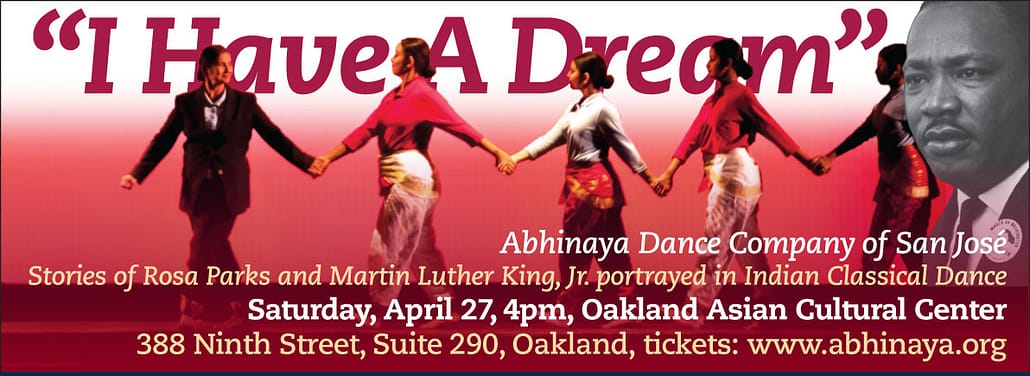Abhinaya’s Dream, Asian Cultural Ctr Oakland April 27, 2019.. Wooly Western eye
It was a sunny Saturday afternoon emerging from Oakland’s 12th Street BART Station en route to see Abhinaya Dance Company of San Jose in their new production “I Have A Dream” at Oakland’s Asian Cultural Center. Not a long walk, past some glass-dominated facades, I found myself in Old Oakland with its beautifully kept facades of late 19th century buildings where you could stare through the windows to the back wall. On the side streets intersecting Broadway, a few of the edifices had shops below street level, some already occupied. These handsome relics of history ache for occupancy.
Cheek by jowl and opposite a Marriott Hotel, Oakland’s Chinatown starts its buildings and enterprises; two blocks eastward in this East Bay pocket stands the Asian Renaissance Building with Oakland’s Asian Cultural Center, adjoining a substantial apartment building. An escalator takes you to the second floor with the Center [Suite 200] in the middle of the second floor construction, its circular architecture featuring a plaza and fountain on the ground floor. Upon asking, I was told the complex was constructed in 1994.
That was not the end of the surprises. To the left of the Center’s entrance along the corridor leading to the rest rooms are exhibits of children’s accomplishments in the Korean art of bojagi, the Korean wrapping cloth on view until June, the result of San Francisco’s Claire Lillenthal School’s Korean immersion program. The fliers in the lobby also invite one to learn Mongolian Traditional Dances at the Ger Academy, their results Carlos Carvajal said made such an impression at the Ethnic Dance Festival auditions.
The auditorium itself uses black and chromium movable chairs for its seating. One can imagine dances and banquets as regular offerings at the Center. But on this particular afternoon it was the remarkable Abhinaya Dance Company of San Jose dancing “I Have a Dream.”
Utilizing images and texts on a screen at vital moments, Abhinaya covered the early life of Martin Luther King in the context of African-American experience of segregation, violence and the historic Montgomery bus strike. Rasika Kumar essayed the role of Rosa Parks with eloquence, Mythili Kumar, M.L. King, and five young skilled exponents of Bharata Natyam undertook with gestures, bell-emphasized footwork and their eyes, outlined in black, the roles of African Americans, members of the Klu Lux Klan, and the police.
This is not the first time Abhinaya has undertaken social commentary using the South Indian classical dance form Bharata Natyam as its expressive vehicle. It has portrayed women in history and the life of Gandhi. It is logical that King’s life and career, inspired by Gandhi’s non-violent campaign against the British, be another subject for artistic comment.
Rasika Kumar was responsible for the choreography and the application of abhinaya, the gesture language, in conveying the story. While many gestures were self-explanatory, the few not understood did not deter from the strength and understanding of the exposition, reinforced with the bells and the eloquence of the eyes. The timing of the gestures, the movements and the expressiveness of eyes and face to the historic progression of the civil rights struggle were amazing, the caliber of dancing simply first rate.
Abhinaya Dance Company and the Kumar trio occupy a special place in the San
Francisco Bay Area’s artistic life, reinforced by the skilled devotion of Mr. Kumar’s technical support. Several dozen Bravos are in order.
Review by Renee Renouf



